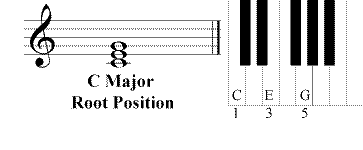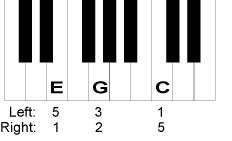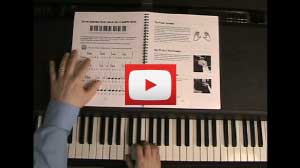Chord Inversions -
Beyond Root Position
Root Position
Before we describe chord inversions, let's review what a "root" position triad is. A triad in root position has the note for which the chord is named in the lowest position. Written on the staff, the chord will be placed on three consecutive lines, or three consecutive spaces. Below is the "C" chord in root position:

Inversions:
With chord inversions we can change the order of the notes in the chord. A "C" chord in root position has the notes C,E and G from low to high. "C" is the "root," or "one" of the chord, "E" is the "third" of the chord, and "G" is the "fifth" of the chord.
Though we can change the order of the notes, the note "C" still functions as the "root," that is, the note that for which the chord is named. "E" still functions as the "third," and "G" still functions as the "fifth." So, though the notes are not in "root" position, we still have a "C" chord. As a matter of fact, any combination of the three notes C, E and G will result in a "C" chord. This "rule" holds for all major and minor triad chord inversions.
First Inversion
To make a first inversion of a root position triad, we take the lowest note (the root) and simply move it to the top. For example the root position "C" chord, is C,E, and G from low to high. The first inversion "C" chord will now be E,G and C from low to high. Notice on the staff how the first inversion triad has one note by itself on the top of the chord. This makes it easily recognized. The graphic also shows the finger numbers to play the inversions.

Second Inversion
We can change the order from low to high again, this time with the "fifth" as the lowest note. Now the "C" chord will be played as G, C, and E from low to high. Notice on the staff how the triad in second inversion has two notes together on top. Again, this is helpful in recognizing the second inversion triad.

Dig A Little Deeper...More About Chords...
Return to "What is a Chord"
Learn about triads: major, minor, augmented, diminished and seventh chords.
Start Playing Piano Today With the Piano Guide Quick Start Course!
Easy to follow, step by step lessons designed for adult beginners. The next best thing to private lessons!
What You'll Learn:
- Notes on the piano/keyboard
- Proper fingering
- C major scale
- Chords
- How to read music
- And much more!
Video lessons - watch as I play everything for you
Downloadable pdf text and mp3 audio files


